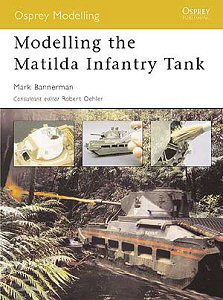

 Modelling
the Matilda Infantry Tank
Modelling
the Matilda Infantry Tank Review by Peter Brown
First up is an A11 as used in France in 1940, this is the Cromwell Models tiny Combat Ready model finished as a tank with 4th Battalion The Royal Tank Regiment at the tank’s finest - and only - hour in action at Arras in 1940 with details of painting and shading the model to best advantage.
All the other models are of the longer-serving Matilda II. In the smaller scales, we start with Arthur Sekula’s building of the 1/76 Fujimi kit in the unusual stone wall scheme as used on Malta which is certainly distinctive. Following that we have a short gallery section showing the ESCI 1/72 kit in Desert markings by Rick Bennett, I would point out that I think its markings are not accurate as it shows a tank with 1st Armoured Division and the white-red-white recognition marking used in Operation Crusader in 1941 when as far as I know this Division did not use Matildas in North Africa. Both these models are essentially straight from the box.
The rest of the modelling features all use Tamiya’s 1/35 kit, which has been around for some time and has recently been re-released. First version depicted is the Australian Frog flame-thrower which uses the MR Models conversion set with its new turret and various hull fittings plus aftermarket photo-etch and tracks. This is accompanied by several good detail photos of preserved Frogs and includes step-by-step coverage of painting and weathering the model.
Following this is a Matilda as it is best-known as Queen of the Desert. The model by Sean Dunnage is of a tank serving in the early part of the North African campaign at a time when there was little which could take on these tanks. It includes a scratchbuilt interior and improved exterior, finished in the three-tone "Caunter" scheme. A bonus is a Ron Volstad painting of an RTR crewman in winter dress, long trousers and battledress blouse along with the distinctive beret and ubiquitous cup of tea.
Next up comes a model by Steve Zaloga of a Matilda in France in 1940, this was covered in Military Modelling magazine some time ago and corrects some of the shape issues with the basic kit as well as converting it into the initial production type used at the time. Those who have the original article will find little new here though it is useful for those who missed it when it first came out.
Then we have another short feature on a model of another Desert tank by Juan L Mercadal Pons, showing how he improved the basic kit into a vehicle with 7RTR.
A more ambitious project is Mark Cooper’s conversion into an unusual real-life rebuild of a captured tank in German use as a self-propelled gun. While this vehicle gets several mentions in print, details of the changes made are not clear though the finished item is certainly different!
Each main section is headed by a listing of the items used in the model and a rating of the level of skill needed to produce it which will help those who want to produce something similar themselves. As well as these main features, there is a section listing tanks on view in collections around the world with photos including some inspiration for an Australian dozer tank, recommendations for further reading in the form of books and websites, and a "kitography" of available models and accessories. Added to the short introduction on the tank and its history, some basic modelling and tools idea and a list of the many production and experimental variants, this book has a lot included in a small space and should prompt modellers to dig out the old kits or go and buy new ones to produce a model or two of this tank.
Copies should be readily available from the usual stockists.
Page created 29 February 2004